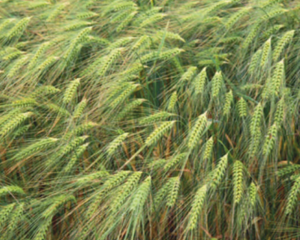Evolution and agriculture
進化和農業
Good catch
豐收
Some crops can absorb phosphorus from dust
有些作物能從塵土中吸收磷
Wheat was among the first plants to be domesticated and is now the most widespread crop in the world. It thus sounds unlikely there would be much left to learn about what makes it thrive. Yet, some 12,000 years after relations between people and wheat began, a wheat plant has been caught doing something unexpected. It helped itself to a dose of much-needed phosphorus when its leaves received a coating of desert dust.
小麥是最早被馴化的植物之一,現在已經是非常普遍的農作物。所以,小麥還有很大的發展空間這種事情聽起來似乎不太可能。然而,在人類和小麥建立聯系的大概12000年之后,人們發現小麥做了一些不可思議的事情:當它的葉子被覆蓋上一層沙塵時,它竟幫自己獲得了所需的磷。
The plant(or, rather, plants)in question were in the care of Avner Gross of the Ben Gurion University of the Negev, in Israel. As Dr Gross told this year's meeting of the American Geophysical Union, which took place online during the first half of December, his study was prompted by hikes he had taken near Neve Shalom, his home village in the Judean Hills. On these, he often noticed plant leaves completely covered in dust that had been carried there by sand storms from the Sahara desert.
我們所說的這株植物(或者更確切地說,多株植物)由以色列內蓋夫本古里安大學的阿夫納·格羅斯照料。格羅斯博士在今年12月上半月在線舉行的美國地球物理聯盟會議上說,他的研究受自己在猶太山的家鄉尼夫沙洛姆附近徒步旅行時所啟發。那會兒他經常注意到,植物的葉子被撒哈拉沙漠的沙塵暴帶到那里的灰塵完全覆蓋。

It occurred to him that this dust might not be the light-blocking nuisance it appeared at first sight. It could, on the contrary, be beneficial because of the growth-enhancing elements such as phosphorus which it contained. Until then, botanists had assumed that phosphorus in dust landing on a plant was of little value, because it is locked up in an insoluble mineral called apatite. This makes it unavailable for absorption. Dr Gross, however, reasoned that plants which had evolved near deserts, the source of almost all naturally occurring dust in the atmosphere, might well have evolved a way to exploitit.
之后他想到,那些灰塵可能并不是一眼望去的那種阻擋光線的令人生厭的東西。相反,它們可能是有益的,因為灰塵里含有某些能夠促進生長的元素,比方說磷。在此之前,植物學家一直認為落在植物上的灰塵中的磷并沒有什么價值,因為它被鎖在一種叫做磷灰石的不溶礦物中,無法被吸收。然而格羅斯博士推斷,沙漠是大氣中幾乎所有自然產生的灰塵的來源,而那些生長在沙漠附近的植物很可能已經進化出了一種利用沙漠的方式,
He and two colleagues, Sudeep Tiwari, also at Ben Gurion, and Ran Erel of the Gilat Research Centre, therefore started experimenting with a pair of species, wheat and chickpeas (the world's 17th most planted crop), that both came originally from the Middle East. As a control, they also raised some maize, a plant from the Americas that evolved in farless dusty surroundings.
因此,他和他的兩個同事,即同樣在本古里安工作的蘇迪普·蒂瓦里和吉萊特研究中心的拉恩·艾勒伊,開始用來自中東的農作物小麥和鷹嘴豆(世界上種植最多的農作物里排行17)這兩個物種進行實驗。此外,他們還種植了玉米作為對照,玉米是一種來自美洲的植物,在塵土較少的環境中進化而來。
譯文由可可原創,僅供學習交流使用,未經許可請勿轉載。











